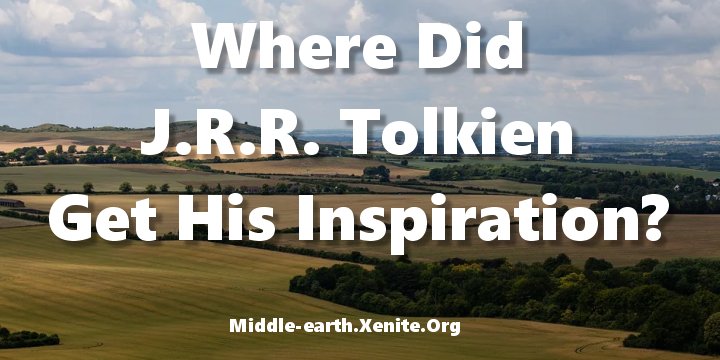
Q: Where Did J.R.R. Tolkien Get His Inspiration?
ANSWER: J.R.R. Tolkien began writing down stories when he was 7 years old. The earliest story he could remember writing late in his adult life was about a green dragon. Tolkien and his younger brother Hilary also had a penchant for inventing secret languages. It is almost as if he was born to tell stories in as many languages as possible.
A writer’s influences and inspirations may be legion. There can be no doubt that a good writer is drawn deeper into his or her own experiences, to imagine how things might have played out differently for many situations. Tolkien’s writing was no doubt strongly influenced by his personal experiences in many ways.
However, there are probably only a handful of critical events in J.R.R. Tolkien’s life that would inspire him to write stories in a sort of cathartic process to help him deal with the emotional traumas he experience. For example, he lost his parents at a very young age. Arthur Tolkien died when John Ronald Reuel Tolkien was only 3 years old. Mabel Tolkien died when John was 12. The Tolkien sons were then fostered by Father Francis Murray of the Roman Catholic Church. Many of the characters in Tolkien’s stories lose their parents and/or take in foster children.
When J.R.R. Tolkien was 16 years old he met Edith Bratt. She was older than he by 3 years but he fell deeply and intensely in love with her. When Father Morgan learned of the relationship he forbade his ward from seeing Edith again. They comprised and agreed that JRRT should wait until he was 21. When that day came Tolkien expressed his continuing feelings for Edith but learned to his dismay that she was on the verge of marrying another man. He rushed across England to win her back and they were eventually married. Many of the characters in Tolkien’s stories are “star-crossed lovers” who either suffer through long-distance relationships and obstacles placed before them by angry fathers, or whose loves go unrequited or otherwise unrewarded.
In 1914 the First World War broke out across Europe. J.R.R. Tolkien eventually joined the British army like all of his friends. Unlike most of his friends and acquaintances, however, Tolkien survived the war. His most bitter experience during the war was to participate in the Battle of the Somme, which began on July 1 1916 and continued up through November of that year. The British Army lost 60,000 soldiers on the first day and suffered over 400,000 casualties throughout the battle. The French lost 200,000 men and the Germans lost 500,000 men.
The Battle of the Somme was one of the most dreadful engagements in the First World War. It not only wiped out more than 1,000,000 lives it destroyed the landscape. The battle achieved nothing strategically for either side in the war and ultimately led to the dreary trench warfare which in itself took a heavy toll on Allied soldiers. Tolkien was sent back to England to recover from so-called Trench Fever and it was while he was in the hospital that he began to write down the stories that would evolve into his Silmarillion mythology.
There are echoes of the Somme throughout many of Tolkien’s stories about war and death. Mordor has been compared to the ghastly, devastated battlefields of the war. Tolkien detested the reduction of the individual will and personality that soldiers experienced through their training and wartime experiences. They became expendable numbers in a massive collision of bureaucratic machines. The “machine”, to Tolkien, was all that civilization uses to crush and confine the will of the individual, and he hated it. The struggle to free the world from the domination of dark overlords who wanted to enslave all thinking, rational creatures became a common theme in Tolkien’s “Middle-earth” stories.
But Tolkien also had more whimsical and yet equally profound inspirations. For example, he devised many stories to amuse and entertain his children. He might draw upon popular or mysterious animals or the toys his children played with, bringing them to life in creative fashion. Bears are a motif that occur in at least two of Tolkien’s stories: the Polar Bear of the Father Christmas Letters being the most well-known example, but Beorn the Skin-changer who took on the form of bears being another.
Many people have wondered where Tolkien got his ideas for hobbits. They have been compared to rabbits but there is strong linguistic evidence to suggest that he modeled some hobbit customs on the ways of badgers. Tolkien himself pointed to the quiet country shire folk he grew up around as inspirations for the Shire-folk of The Lord of the Rings, so he clearly blended many influences in creating the character and nature of hobbits.
Tolkien’s love for languages manifested it in his professional career as a Philologist and scholar of ancient language. He studied and is said to have mastered many languages including Greek, Latin, Gothic, Old English, Old Norse, and Icelandic, as well as “smatterings” of many other languages. Tolkien was a devoted student of history and classical literature and mythology. He sprinkled traces of ancient Greek, Roman, Egyptian, Babylonian, and northern European history and mythology throughout his stories.
See Also:
Was Tolkien Inspired by the Door of St. Edward’s Church in Gloucestershire
What Was J.R.R. Tolkien’s Inspiration for Lake-town in The Hobbit?
What Was Tolkien’s Inspiration for the Mearas?
What Was J.R.R. Tolkien’s Inspiration for the Barrow-downs?
How Did J.R.R. Tolkien Create Middle-earth?
Were Battles in The Lord of the Rings Inspired by any Historical Events?
Tolkien’s Time Machine: When Literary Worlds Collide
# # #
Have you read our other Tolkien and Middle-earth Questions and Answers articles?
